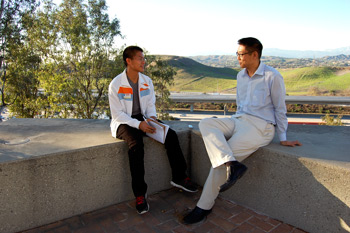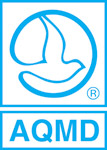Smog buster
Have you ever wondered what is in the air we breathe? I have because I love to play outdoor sports like basketball and water polo and hike. But from reading online, I’ve learned that there are tons of pollutants and toxins in the air that harm people who have respiratory diseases such as asthma and that can make healthy people sick. The worst part is that our actions can contribute to these problems, from the cars we drive to the way we mow our lawns. Air pollution is a serious problem because it affects all of us. I care about pollution because I want to live a healthy life, and I want my family and friends to live healthy lives too.
I recently had an opportunity to interview Jack Chang, an air quality staff specialist at the South Coast Air Quality Management District (AQMD). Before the interview, I didn’t know what AQMD did. I learned that AQMD is the government agency that is in charge of protecting our health from air pollution. They regulate air quality in the South Coast Air Basin, which includes all of Orange County and most of Los Angeles, San Bernardino and Riverside counties. They make the rules that regulate air pollution from businesses. I was curious about how AQMD worked and how they enforced the rules they set.
I met Jack at the AQMD offices in Diamond Bar and we decided to do the interview outside in the courtyard overlooking a steady stream of traffic on the nearby freeway. Seeing the traffic was a reminder of all the harmful pollution coming from cars.
L.A. Youth: Can you describe AQMD’s roles?
Jack Chang, air quality staff specialist: The federal government has set standards for each pollutant and we have to come up with a plan [to meet those standards]. We have many roles here. We have the role of inspectors in the compliance division; they are the eyes and ears of the facilities out there. During the construction phases we’ll get involved if there is dust or complaints. We have our air quality management plan, which addresses what’s our strategy to get to [a healthy air quality] level.
What did you do as a field inspector?
I was an inspector in the toxics group. We dealt primarily with asbestos during the demolition of homes and buildings to make sure that all of the asbestos is being contained and disposed of properly. We also did inspections at landfills as well as gas stations.

Jerry (left) talked to Jack Chang about what the Air Quality Management District is doing to reduce air pollution.
So you guys are like the air quality police?
We’re not going out there arresting people, but we do write tickets to companies when they are violating air quality rules. A long time ago, air pollution inspectors would drive around in squad cars similar to police cars and carry badges and inspect businesses. We’re more scientific now.
Were you curious about the environment when you were a kid?
Growing up my parents would always say, “Don’t waste,” stuff like that. I grew up in the San Gabriel Valley and I remember the smog alert days and not being able to go out during recess [because the air was unhealthy]. Since 1990 we haven’t had a smog alert in L.A. There’s always room for improvement. It’d be great to be able to see the mountains every day during the summer.
What got you into this field?
I was always interested in science and math. In college I studied environmental science and I felt like this career path was something that was really relevant. It’s practical and a topic that needed to be addressed.
Did you know you would do this in college?
No, I didn’t. I just knew coming out [of college] that this was a practical major that you could apply immediately. It wasn’t just about information in a book. As an inspector, you get to use math and biology and chemistry skills. You do calculations on the fly. When people are not giving you a complete picture, you have the information.
Is this something you enjoy doing?
I feel really rewarded in what I do. My job has a direct impact on air quality and the people around me. I’m giving back. You’ll have friends every so often mention air quality or say, “So there’s this new rule that came out that impacts my boss,” and you kind of laugh because you’re like, oh that’s me. It’s nice to know we’re far-reaching and we do have an impact.
Click here to read:
Brian’s story about how our smoggy air affects his asthma.
l
 This special package is funded by the South Coast Air Quality Management District. Los Angeles has some of the dirtiest air in the country, which means that many days we’re breathing in smog that is bad for our health. What is smog? Smog refers to all the pollutants in the air. There are several air pollutants, including some that are colorless (so you can’t always tell how smoggy the air is just by looking at it). Driving is a big source of air pollution. Other sources are power plants, emissions from businesses and dust. Los Angeles air has gotten cleaner, but there were still 100 days last year when the air quality was not healthy. In this special package you can learn more about smog, including what you can do to help reduce pollution.
This special package is funded by the South Coast Air Quality Management District. Los Angeles has some of the dirtiest air in the country, which means that many days we’re breathing in smog that is bad for our health. What is smog? Smog refers to all the pollutants in the air. There are several air pollutants, including some that are colorless (so you can’t always tell how smoggy the air is just by looking at it). Driving is a big source of air pollution. Other sources are power plants, emissions from businesses and dust. Los Angeles air has gotten cleaner, but there were still 100 days last year when the air quality was not healthy. In this special package you can learn more about smog, including what you can do to help reduce pollution.







